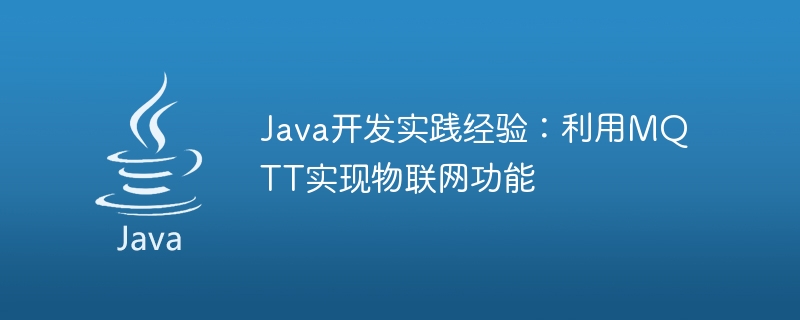

With the development of IoT technology, more and more devices are able to connect to the Internet and communicate and interact through the Internet. In the development of IoT applications, the Message Queuing Telemetry Transport Protocol (MQTT) is widely used as a lightweight communication protocol. This article will introduce how to use Java development practical experience to implement IoT functions through MQTT.
1. What is MQTT
MQTT is a message transmission protocol based on the publish/subscribe model. It has a simple design and low overhead, and is suitable for application scenarios that quickly transmit small amounts of data. MQTT supports multiple transmission methods, including TCP, TLS, WebSocket, etc. It is widely used in the field of Internet of Things and can realize real-time communication and data transmission between devices.
2. Basic concepts of MQTT
3. Use Java development practical experience to implement MQTT function
4. Example: Temperature and humidity monitoring system based on MQTT
Taking a temperature and humidity monitoring system based on MQTT as an example, we will introduce the practical experience of Java development. The system consists of a temperature and humidity sensor and a display interface. The sensor publishes the temperature and humidity data to the specified topic through the MQTT protocol, and the display interface subscribes to the topic through the MQTT protocol to display the temperature and humidity data in real time.
First you need to create an MQTT client and connect to the MQTT proxy server. Then create a publisher object and publish the temperature and humidity data to the specified topic by calling the publish method. Create a subscriber object and subscribe to the topic's messages by calling the subscribe method. In the subscriber's callback method, the data can be parsed and displayed after receiving it.
Through Java development practical experience, we can more easily use MQTT to realize the functions of the Internet of Things. In addition to basic connection, publication, subscription and disconnection operations, IoT applications can be further expanded and optimized by integrating other technologies, such as databases, cloud services, etc.
Summary: This article introduces the basic concepts of MQTT and how to use Java development practical experience to implement MQTT functions. This example illustrates how to use MQTT to implement an IoT monitoring system based on temperature and humidity sensors. With the continuous development of IoT technology, MQTT, as an efficient and reliable communication protocol, will be applied and promoted in more IoT applications.
The above is the detailed content of Practical experience in Java development: using MQTT to implement IoT functions. For more information, please follow other related articles on the PHP Chinese website!
 What are the applications of the Internet of Things?
What are the applications of the Internet of Things?
 The m2m concept in the Internet of Things
The m2m concept in the Internet of Things
 The difference between c language and python
The difference between c language and python
 cookie
cookie
 How to solve the problem that js code cannot run after formatting
How to solve the problem that js code cannot run after formatting
 What interface is audio?
What interface is audio?
 The m2m concept in the Internet of Things
The m2m concept in the Internet of Things
 Commonly used linux commands
Commonly used linux commands




